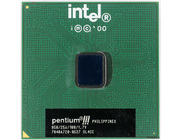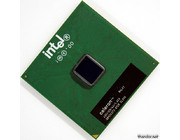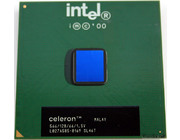The second Pentium III, which is available in speeds ranging from 500MHz to 1133MHz. It performed better than the 'Katmai' (first Pentium III) due optimizations. The Pentium III was a strong performer but AMD did not stop increasing clock frequencies. To keep up Intel had to release faster versions of the Pentium III but was struggling around 1GHz. Yields weren't good which caused delays and so called paper-launches (product is launched, but practically not for sale).
I have two other Pentium III 866's: one cC0-stepping with slot 1 packaging and one cC0-stepping with S370 packaging just like this CPU. The only difference is that this one is equipped with the newer cD0 revision core. At that time Intel also changed the printing on the chips a bit: the big Intel logo disappeared and the black rectangles with chip information became smaller.
In performance terms this CPU is identical to the cC0-stepping. As far as I know most changes have been made in thermal dissipation and optimizations to reach higher clock frequencies. > Read more
The Pentium III came in many variations including the 800EB. The EB model indicates that it is a 133MHz FSB version with Coppermine-core. The 800MHz model is also available with a 100MHz FSB which is usually noted without the EB-suffix.
I have another 800EB that is a few weeks older and is based on the cB0 stepping rather than cC0. > Read more
The looks of a Pentium III 1000 'Tualatin' but secretly a 'Coppermine' underneath. One give-a-way is the 1.75 vCore it needs ![]() .
.
At one point in time Intel decided to use FC-PGA2 packaging's for their latest Celeron and Pentium III CPU's. I wrote more about FC-PGA2 in the story of this Celeron 900. > Read more
An ordinary, run of the mill, Celeron CPU. Not very spectacular, not the slowest (533MHz) in it's line nor the fastest (1100). These usually ended up in budget systems could run Office applications fair enough ![]() . > Read more
. > Read more
Pentium II's came in the slot-1 packaging and early Pentium III's followed suit. These CPU's were fitted in a larger packaging to make room for external L2-cache that ran at 50% of the CPU clock frequency. At the time it was too expensive to integrate L2-cache inside the CPU-core itself.
As technology evolved the L2-cache eventually moved closer and was integrated in the CPU-core. This lowered access times and caused the L2-cache to run at full-speed resulting in faster performance. Another benefit was the use of smaller CPU packaging: the Pentium III became available for socket 370.
Most faster Pentium III's (Coppermine cores, speeds around 667MHz and faster) were built for the S370 socket. To facilitate those who already bought a 133MHz-capable slot 1 system, Intel also manufactured the faster models in slot 1 form. It's exactly the same chip but housed differently. > Read more
Intel launched the Pentium 4 platform (for desktops) in November, 2000. However, the Pentium 4 wasn't suitable for mobile applications due to it's higher energy consumption. Intel still used the Mobile Pentium III at that time. The Pentium-M wasn't available until March 2003 so in the meantime CPU's like this 800MHz Pentium III, and later, Pentium III-M up to 1.33GHz, filled in the gap on the mobile market.
800MHz or 1.33GHz may not sound like much and yes, they weren't performance crowns. But don't fall for the 'MHz-myth': the Pentium 4 may have higher clock-frequencies but the Pentium III is more efficient per MHz. Depending on the application a 1.33GHz (Tualatin) may be faster than a 1.5GHz Pentium 4 (Willamette), and in some cases even match up to 1.8GHz or 1.9GHz Pentium 4 ![]() . > Read more
. > Read more
Just like this one but with different sSpec number. > Read more
The first Celeron with 100MHz bus. The 766 model was starting to lack bandwidth due the slower 66MHz bus, and AMD's Duron was rocketing along with far greater performance. Intel tried to close the gap a bit by using a faster bus. > Read more
A Celeron at the 1GHz mark; a good thing for marketing and business. The processor did it's job but was nowhere as fast as a Duron. > Read more
The Pentium III 1100 is the fastest Pentium III 'Coppermine' that uses a 100MHz FSB. Faster models (1133MHz, and the later Tualatin CPU's) use the faster 133MHz bus. In some situations (for instance when playing games) the 133MHz makes a difference. I guess the 1100MHz didn't sell much and people that bought faster Pentium III's (933MHz+ models) usually went for a system with a 133MHz FSB. Even in OEM-channels ![]() . > Read more
. > Read more
Introduced in May 2000, two months after the release of the 1GHz Pentium III and a few months before the release of the Pentium 4 'Willamette'. > Read more
Introduced in October 2000. It uses a 100MHz FSB and sometimes it's outperformed by it's 866MHz brother which has a 133MHz FSB. Using Office applications the front side bus won't matter as much compared to games or memory intensive applications. > Read more
A nice performer for March 2000. It was released a few days after the 1GHz part. Intel quickly launched the, by then unavailable, high-end Pentium 3's under pressure of AMD's 1GHz Athlons. AMD dropped their 900MHz, 950MHz and 1000MHz parts at once in March 2000 to claim the performance crown and to break the 1GHz barrier.
All in all the 866MHz version was a nice performer in it's day. Depending on the application it was a neck-on-neck race with the Athlon. Some applications favoured the Athlon, some favoured the Pentium III.
When this CPU was new the Athlon used SDR-SDRAM just like the Pentium III. In later (and high-end) systems the Athlon CPU's were often fitted with DDR-SDRAM which greatly increases memory bandwidth. In most cases where the Pentium III 866 would outperform the Athlon (850/900) with SDR-SDRAM; that same Athlon with DDR-SDRAM would outperform the Pentium III. > Read more
Just like the 900MHz part this CPU also features a 100MHz FSB. In some memory intensive applications the 850MHz part is superseded by the 800MHz 'EB' CPU, which as you've probably guessed already, features the faster 133MHz FSB. > Read more
Being released in October 1999, this CPU was one of the fastest around. Performance wise I guess the 733MHz Pentium III is a little bit faster than it's rival, the AMD Athlon 700 (also October 1999) paired up with AMD's Irongate chipset. > Read more
The 600E is equipped with a Coppermine core; a significant improvement, but not as much as the 600EB, over the old Katmai core (The 600 and 600B; the latter uses a 133MHz FSB). The Katmai at 600MHz had a TDP of 42W whereas the Coppermine was satisfied with just 15.8W. Not to mention the cheaper manufacturing costs due to a smaller but faster on-die L2-cache and an overall smaller chip as result of a die-shrink. > Read more
Compared to the first generation Katmai CPU's, this Coppermine runs fairly good. A proper improvement over the Pentium II whereas the Katmai didn't improve much. > Read more
Just like the 600E but with 133MHz front side bus. The higher front side bus provides more throughput and higher memory bandwidth. > Read more
An engineering sample Celeron with an 100MHz front side bus. Luckily Intel stopped increasing the multiplier of the older 66MHz bus versions because they will eventually reach a point that the front side bus is getting to slow. > Read more
Both the Celeron 667 and the Pentium III 667 are made using a 180nm Coppermine core. The difference can be found in the front side bus and L2-cache size. Let's see how this affects the performance in the benchmarks. > Read more
Like the 566 and 600 model but faster and still with the slow 66MHz bus. Luckily the Celeron was quite energy efficient so it was not bad for notebooks. > Read more
I can't really say anything about this CPU. Just like the 566, 633 and 667 models they were probably sold in quite some quantities but in reality they got out-performed by AMD's Duron. > Read more
The same as this 566 Celeron. Even the sSpec number is the same. I bought this CPU because I didn't have a working 566 model for the benchmarks. > Read more
Just like this Pentium III 1000 but a bit older. It has a cC0-core instead of cD0 and the sSpec number is on a bigger black label. > Read more
Just like this Pentium III 667 but then in slot 1 form.
Two things can be noticed about this CPU: one is that it has a big passive heatsink attached. If I remember correctly this CPU was pulled from an HP/Compaq system that used a shroud solution to pull air from the case, through the CPU heatsink and out of the back. A nice way to minimize fans and to avoid the use of fragile 40mm fans.
Another thing is it's early production date. The Intel Coppermine was introduced in October 1999 and it's release price was 605$. This CPU was part of quite an expensive and fast (at the time) computer! > Read more
Unlike the Celeron at 500MHz or 533MHz this one has been made with the so called 'Coppermine' core. It's made on a 180nm manufacturing process and because of this it can run at higher clock frequencies with less voltage.
The Coppermine CPU's on socket 370 are also FC-PGA rather than PGA. FC stands for Flip Chipped and PGA for Pin Grid Array. Essentially both are housed in a plastic cpu package but the Coppermine has the chip backwards to allow for better cooling and easier connection with the pins in the plastic housing. You can easily spot the difference by it's color: the packaging of FC-PGA Celeron's is green. The older regular versions are black. > Read more
No, this is not a 'Tualatin' as many would think because they see a heatspreader. This is a FC-PGA2 'Coppermine' CPU which is also known as the Coppermine-T. As since all FC-PGA2 CPU's have a heatspreader, this CPU has one too.
A little story on the PPGA, FC-PGA and FC-PGA2:
PPGA stands for Plastic Pin Grid Array. It means the CPU has a plastic packaging and some pins. Compare it with an old socket A AMD Athlon as they have CPGA, which is Ceramic. PPGA was the technique Intel used for their first generation Celeron's using a 'socket' instead of 'slot'.
FC-PGA stands for Flip-Chip Pin Grid Array. As the name says, it's flipped. A processor has a 'die' which is the packaging of the 'core'. The 'core' is the actual 'logic' or easily said: processor (For a better understanding see this image. The blue thing is the 'die'.). With FC-PGA the 'die' is flipped so it will face downwards on the packaging on which the back of the 'die' will be exposed. In the linked picture you are actually looking at the back of the 'die'. The advantage is that the heatsink can have a more direct contact.
FC-PGA2 is the second version of FC-PGA and all it does is including a heatspreader. In my opinion 'heatspreader' is not the correct word as it doesn't spread the heat. It merely blocks the heat as the heatspreader is just an extra layer between the 'die' and the heatsink. The less layers, the better the cooling. The actual job of the heatspreader is protection. The 'die' won't fry immediately when the PC is turned on without a heatsink installed on the CPU. Neither people can crush the fragile 'die' by installing the heatsink incorrectly.
The CPU works like a charm but is not as fast as an Intel Pentium III or AMD Athlon/Duron. Not surprising as the Celeron is Intel's budget-line CPU. Though times have been better in the past. The older Celeron 'Mendocino' was practically ahead at it's bigger brother, the Pentium II. The Pentium II had 512KB off-die L2 cache at 50% of the internal clockfrequency. The Celeron had 128KB on-die L2 cache at full speed. A bigger cache is usually faster but a faster, yet smaller cache, is often better. But, all this will turn out when the benchmarks of the 'Covington', 'Mendocino' and 'Deschutes' are up ![]() . > Read more
. > Read more
A regular, yet nicely performing Intel Pentium III processor. The first Pentium III's were released for the Slot 1 platform just like the Pentium II. Along with a 440BX platform they ran fine but still used the older platform from the Pentium II-era.
This 667MHz really marks the 'new age' for the (FC-PGA) Pentium III line. It plugs into the newer 370-pin socket, uses a faster 133MHz bus and at the time of release newer motherboards appeared that supported, AGP4x, Ultra ATA66 and PC133 SDR-SDRAM.
Because it features a 133MHz FSB it will sometimes be faster then a 700MHz part with 100MHz FSB. Especially when bandwidth is needed.
The Pentium III did get another iteration: FC-PGA2. FC-PGA2 is mostly known for it's Tualatin CPU's but also housed Coppermine CPU's. > Read more
Due to the 133MHz FSB this CPU was quite good. The 'EB' mark indicates we are dealing with a 'Coppermine' core. Actually Intel used the 'E' mark for denoting the 256-bit wide cache bus but since all 'Coppermine' cores featured that one can simple say 'E' is the same as 'Coppermine'. The 'B' stands for 133MHz FSB.
> Read more
Right at the 1GHz barrier! The Intel Pentium III 1000MHz with 133MHz FSB. This one should be interesting against an AMD Athlon 1000MHz ![]() . The Intel part will probably win in situations where SSE is utilized because AMD's 'Thunderbird' didn't have SSE implementations. AMD's 'Palomino' core (Athlon 4, Athlon MP, Athlon XP) were the first AMD CPU's to support SSE.
. The Intel part will probably win in situations where SSE is utilized because AMD's 'Thunderbird' didn't have SSE implementations. AMD's 'Palomino' core (Athlon 4, Athlon MP, Athlon XP) were the first AMD CPU's to support SSE.
The Pentium III with 'Coppermine' core was nearing it's limits around 1000MHz. The first 1133MHz CPU's Intel released were not even stable enough to compile a Linux kernel. Later on Intel released the 'Tualatin' which was more efficient and based upon 130nm production technology. This allowed Intel to sell Pentium III's up to 1400MHz. Overclockers even did their best to get more, in which they succeeded. Intel could probably do more then 1400MHz as well but releasing an 1500MHz CPU would destroy the sales of the Intel Pentium 4 which was new at the time.
The announcement of the Intel Pentium III was two days after AMD announced their 1GHz Athlon. The Pentium III should've been faster but wasn't available at the time. Intel had problems and 'shortage' was a known word. If I remember correctly AMD's production facilities were 12 times as successful as Intel's production facilities. Meaning: Intel had to throw away a lot more defective chips. Though AMD's 1GHz chip wasn't widely available the first six months after the release. AMD only shipped some CPU's to several OEM's. > Read more















































